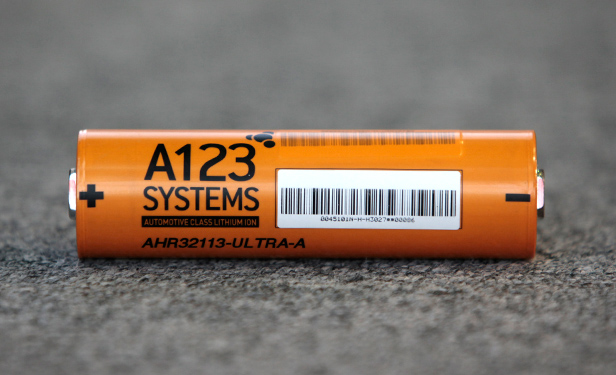A123’s Technology Just Wasn’t Good Enough

Despite the hand-wringing over the role of government in supporting clean energy and some observers’ despair over the future of electric vehicles, the real reason that A123 Systems failed is, arguably, far simpler. The lithium-ion battery maker, which filed for bankruptcy earlier this week, was betting on technology that wasn’t advanced enough to help it overcome the inherent advantages of established manufacturers and compete with them.
A123’s technology, based on nanoscale electrode powders, was safer and far more powerful than existing alternatives when it was introduced in 2006. The technology helped convince GM that lithium-ion batteries could be used in plug-in hybrids, which was important for the development of the Chevrolet Volt. But big battery makers quickly caught up. While they couldn’t necessarily match A123’s performance in all areas, they came close enough to meet the needs of automakers.
In spite of a close working relationship with GM, A123 lost the contract for the Volt to the Korean giant LG Chem, which used more conventional electrode materials but introduced a novel material to separate the electrodes and improve the safety of the batteries. Since then, A123 has signed several production contracts with major automakers, but those haven’t been very large orders so far—not enough for the company to operate its factories at full capacity, which would have brought down costs. Major contracts for vehicles such as the Nissan Leaf, Ford’s new Focus electric vehicle, and Toyota’s plug-in Prius all went to more established battery makers.
And although A123’s technology was an improvement on existing batteries used in electric vehicles, it wasn’t good enough to let such cars, or plug-in hybrids, compete widely with conventional vehicles. While far more compact than the lead-acid and nickel–metal hydride batteries used in early generations of electric vehicles and hybrids, lithium-ion batteries from A123 and other manufacturers remain expensive, accounting for perhaps $15,000 of the cost of a car (see “Will Electric Vehicles Finally Succeed?”). Electric vehicles are twice as expensive as their gasoline equivalents, in large part because of the batteries.
Now that established lithium-ion battery makers are developing batteries for the automotive market, startups hoping to break into the industry will face even greater challenges than A123 did. Battery makers have driven costs down over the last several years, from about $1,000 per kilowatt-hour to $500 per kilowatt-hour, says Yet-Ming Chiang, a materials scientist at MIT and one of the founders of A123. And those costs are likely to be cut in half again over the next decade, he says. If startups are to succeed, they’ll need to offer something far cheaper and higher performing.
The United States Advanced Battery Consortium, a collaboration between major U.S. automakers, has a goal of bringing costs down to under $150 per kilowatt-hour to achieve large-scale commercialization of electric vehicles. “The conventional approach to lithium-ion batteries is not going to drop the costs enough,” Chiang says. “It may drop them by a factor of two, but not by a factor of four. And in the long term we need to be down by a factor of four or more.” (Chiang spoke to Technology Review in his capacity as an MIT professor, not as a representative of A123 Systems.)
That is likely to mean either radically different lithium-ion technology or entirely new types of chemistries. In 2010, Chiang founded a startup, 24M, to try out another strategy for inexpensive batteries—a technology that involves electrodes stored in reservoirs and pumped into a cell to generate electricity (see “A Car Battery at Half the Price”).
And several other startups are pursuing other novel approaches to making low-cost batteries. For example, Pellion, based in Cambridge, Massachusetts, and founded by MIT researchers Gerbrand Ceder and Robert Doe, is developing new magnesium-ion batteries that might increase energy storage by two to three times and could be manufactured on existing equipment (see “What If Electric Cars Were Better?”). Sakti3, which is based in Ann Arbor near the major automakers in Michigan, is developing solid-state batteries that do away with the dangerous liquid electrolytes used in conventional lithium-ion batteries, in part by potentially doubling energy storage by helping to reduce the need for safety systems, according to the company.
But even if these companies are successful in developing novel batteries, they will need to compete with established players who are also exploring major changes to lithium-ion technology. For example, Toyota, which has a joint venture with battery maker Panasonic, is developing solid-state batteries similar to the ones Sakti3 is pursuing.
[Correction: The original version of the article said the liquid electrolyte itself is bulky. It’s the safety systems they require that add bulk to a battery.]
Keep Reading
Most Popular
Large language models can do jaw-dropping things. But nobody knows exactly why.
And that's a problem. Figuring it out is one of the biggest scientific puzzles of our time and a crucial step towards controlling more powerful future models.
The problem with plug-in hybrids? Their drivers.
Plug-in hybrids are often sold as a transition to EVs, but new data from Europe shows we’re still underestimating the emissions they produce.
Google DeepMind’s new generative model makes Super Mario–like games from scratch
Genie learns how to control games by watching hours and hours of video. It could help train next-gen robots too.
How scientists traced a mysterious covid case back to six toilets
When wastewater surveillance turns into a hunt for a single infected individual, the ethics get tricky.
Stay connected
Get the latest updates from
MIT Technology Review
Discover special offers, top stories, upcoming events, and more.